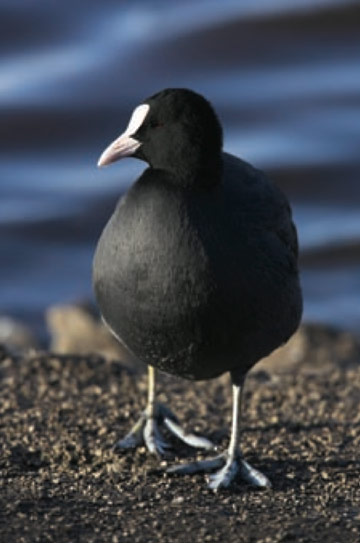
Coot © Simon Booth
After the breeding season, Coots abandon their territoriality and gather into flocks, where our resident birds are joined by immigrants from continental Europe (Migration Atlas). Birds are seldom seen in flight, however – they mostly migrate at night – and little is known about the origins of Coot wintering in Cheshire and Wirral. They abandon some of their breeding tetrads for the winter: this Atlas shows that they were found in both seasons in 313 tetrads, with 95 occupied in the breeding season but not in winter, and 56 used in winter but not for breeding.
The major site for Coots in Cheshire and Wirral is Doddington Pool (SJ74D), where 884 birds were counted in November 2004, not far short of its record winter flock of 1,300 in November 2001. The Doddington gathering was more than twice the size of the next largest reported flock during this Atlas period, 400 on Redes Mere (SJ87K), and Deer Park Mere (SJ55F/ K) was the only other site counting flocks more than 200 strong. Other sites that have sporadically recorded more than 200 birds in the last decade include most of the larger lowland waters: Budworth Mere, Chelford SQs, Houghton Green Pool, Sandbach Flashes, Radnor Mere, Moore Nature Reserve, Rostherne Mere and, briefly, Frodsham Marsh no.6 bed when pumping of dredgings from the Manchester Ship Canal first started in 1995/ 96. No site in the county approaches the threshold for national importance, currently set at 1,730 birds.
Several of those sites have long been favoured by Coots: Bell (1962) lists Radnor Mere, Doddington, Rostherne, ‘and particularly Tabley, where flocks of up to 400 have occurred’. Doddington Pool was the most frequently mentioned location in the early years of the Cheshire Bird Reports, holding 400 or more birds in the mid-1960s. The sizes of the large flocks have grown over the years, and their national winter population index on sites monitored by WeBS has also increased, by about one-third in the last twenty years (Banks et al 2006).
The habitats used by Coots during winter are much the same as in the breeding season, although there is a small shift away from the smallest standing waters (G1 and G2) to linear watercourses (G6 to G10) whose proportion rises from 8% to 13%: most of these birds are on canals. This is a freshwater bird and there was only one estuarine record, two birds in the Mersey (SJ48V): the three-figure totals in the Dee WeBS come from the inclusion of birds on the pools at Inner Marsh Farm with those of the estuary. Coward (1910) reported that Coots were common in the Dee estuary in severe winters. This, however, has not been borne out by any records published since (Bell 1962). In periods of hard weather in recent years, birds have flocked together on unfrozen waters, including the deeper meres and rivers, especially the lower Weaver.
Sponsored by Roger and Kay Millen

